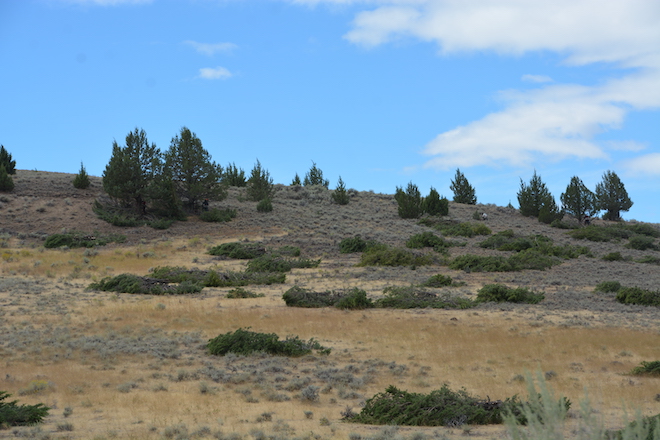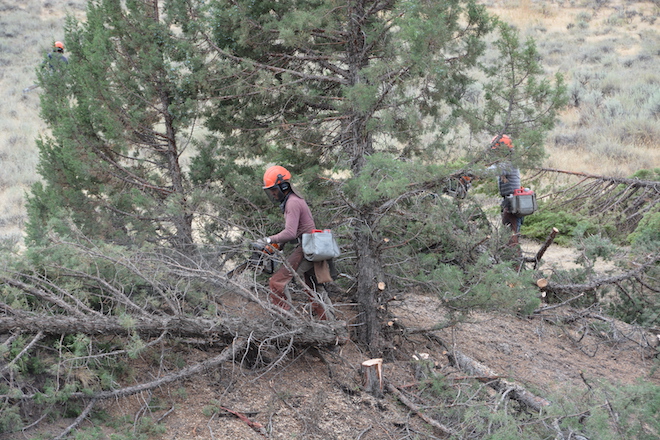Conifer encroachment totals over 9 million acres in American west
By Casey Sill
A recent study in Oregon found juniper removal can have a profound affect on the health of sage-grouse populations across the Great Basin.
Sagebrush ecosystems have been in decline across their historic range for sometime, and no species is more connected to that decline than the Greater sage-grouse. As their name suggests, sage-grouse are linked indelibly to sagebrush, using the habitat during every phase of their lifecycle.
A large portion of sagebrush decline has been linked to juniper and other woody cover encroachment across the Great Basin, an area covering most of Nevada and parts of Oregon, Utah, California, Idaho and Wyoming. This new study links the removal of juniper cover to population-level increases in sage grouse across the region, based on factors including female survival, nest success, chick survival and mating habits.
The encroachment of juniper and other woody cover across the sagebrush ecosystem has increased dramatically since European settlement of the Great Basin during the 1870s. Settlers introduced unregulated livestock grazing and active fire suppression, both of which reduced the frequency of wildfires that had historically limited the expansion of juniper. These practices, combined with favorable climate for tree establishment, allowed woody cover to grow rapidly.

As juniper cover increases, the health of sagebrush ecosystem that grouse and many other species are dependent on, decreases. Sage-grouse numbers have steadily declined in recent decades — Counts of sage-grouse males indicate declines of just under one percent per year range-wide since 1965. And since the grouse are so closely connected to sagebrush habitat, that decline is a useful indicator of overall sagebrush ecosystem quantity and quality.
Juniper cover is detrimental in several specific ways. While decreasing the health of sagebrush habitat, it simultaneously creates excellent cover for sage-grouse nest predators like the common raven, and predators of adult sage-grouse like the golden eagle.
It also reduces the amount of suitable habitat for “leks,” or gatherings of male sage-grouse to display courtship rituals to attract female attention. These typically take place on open ground surrounded by sagebrush habitat — the more of those clearings swallowed by juniper cover, the less ground males have to put on these competitive displays.
The study used GPS marked female sage grouse, nest observation, flush counts and lek counts to determine the impact of juniper removal within the “treatment” area, compared to similar observation data from areas without and woody cover removal. Over the course of the project, 417 hens were captured and marked, 378 nests were observed and 223 broods were monitored. The study counted six leks in the treatment area, with a mean maximum male count of 16. Just three leks were counted in the control area, with a mean maximum male count of 34. Integrating lek and other data in a landscape-scale experiment, the study presented evidence that sage-grouse population growth rates were up to 13% higher where juniper removal occurred.
Methods of juniper removal vary across the sage brush range, but one of the most common methods is what’s known as “lop and scatter.” — which means the trees are simply cut down with a chainsaw and left to dry. After a period of time the trees are often burned, either by moving them into piles or just burning each individual juniper where it lies. Another method of removal is mastication.
“With mastication, or grinding, we bring in a wheeled or tracked machine that will grind each tree into mulch,” said Connor White, a Pheasants Forever and Quail Forever BOSH project coordinator. “That’s typically used in the Utah juniper range. There are several species of junipers. Utah junipers tend to be smaller, making them better suited for mastication than other species such as Western juniper, which can easily grow over 20 or 25 feet tall.”

Pheasants Forever and Quail Forever, along with partners at the Sage Grouse Initiative and numerous other organizations, are doing their best to fight the uphill battle of conifer encroachment in the American west. There are over 9 million acres of conifers that’ve invaded landscapes where they wouldn’t have been historically present, according to Michael Brown, Pheasants Forever and Quail Forever’s manager of innovative finance. To date, between 750-800,000 acres have been cleared.
“So there’s a lot of work left to be done,” Brown said. “It one of the most dominant threats across the western landscape, and the removal of those trees is also one of the best ways to improve that landscape quickly. It not only helps sage grouse populations, but mule deer fawn survival increases, as does the health of sage brush reliant song bird populations — there’s really no downside to conifer removal.”
For more information on juniper removal, visit https://www.pinyonjuniperproject.org/
Casey Sill is the public relations specialist at Pheasants Forever and Quail Forever national headquarters in St. Paul, Minn. He can be reached at csill@pheasantsforever.org.